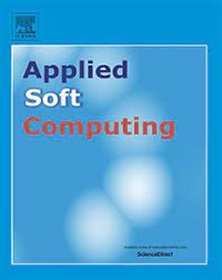A multi-objective cuckoo search algorithm using generalized Lèvy flight and dissimilar egg identification for multispectral image thresholding
IF 7.2
1区 计算机科学
Q1 COMPUTER SCIENCE, ARTIFICIAL INTELLIGENCE
引用次数: 0
Abstract
Cuckoo Search (CS) stands as a highly efficient meta-heuristic optimization algorithm. Existing literature showcases the ability of CS in multi-objective scenarios, delineated by the three fundamental rules. However, the first rule of the algorithm incurs the cost of a generation to update a single nest, while the third rule necessitates hit-and-trial methods for parameter adjustment. To address these concerns, a multi-objective cuckoo search algorithm is proposed in this paper. The algorithm builds upon a generalized concept of Lèvy Flight for generating new solutions. Problem-specific, constraint-based strategies for identifying the best nest and dissimilar eggs are also introduced. The algorithm is further applied to solve multispectral remote sensing image thresholding problem. Prior studies have underscored the efficiency of entropy and clustering-based thresholding methods over other techniques. Nevertheless, most entropy-based approaches entail converting color images to grayscale before segmentation, potentially sacrificing crucial spectral information and consequently degrading segmentation algorithm’s performance. To avoid these limitations, this research introduces an entropy-based thresholding method to segment a color image without converting it to grayscale. The experiments are carried out using very high resolution (VHR) and coarse resolution (CR) multispectral (MS) images from the satellite sensors Pl’eidas-1B and Sentinel-2b, respectively. The proposed methods undergo validation against four state-of-the-art techniques on benchmark functions and six clustering indexes, respectively.
求助全文
约1分钟内获得全文
求助全文
来源期刊

Applied Soft Computing
工程技术-计算机:跨学科应用
CiteScore
15.80
自引率
6.90%
发文量
874
审稿时长
10.9 months
期刊介绍:
Applied Soft Computing is an international journal promoting an integrated view of soft computing to solve real life problems.The focus is to publish the highest quality research in application and convergence of the areas of Fuzzy Logic, Neural Networks, Evolutionary Computing, Rough Sets and other similar techniques to address real world complexities.
Applied Soft Computing is a rolling publication: articles are published as soon as the editor-in-chief has accepted them. Therefore, the web site will continuously be updated with new articles and the publication time will be short.
 求助内容:
求助内容: 应助结果提醒方式:
应助结果提醒方式:


